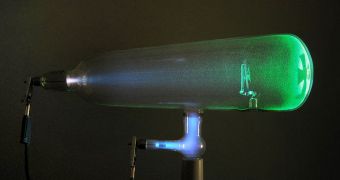A group of investigators from the Princeton University in the United States says that it recently managed to gather more insights into the nature of electrons. They way that scientists did this was by analyzing how single electrons interact with their environment.
Using a complex, laser-based study technique, the experts and the international team that aided them in this research managed to take a peek at the complex and intricate relationships that govern how single electrons relate to their surroundings.
This work could have significant consequences for the global effort to construct a quantum computer, a machine that would harness the power of superposition and entanglement to provide never-before-seen computing power and capabilities.
[AMDARK=1]The Princeton experts say that the relationship that develops between an electron and its environment is called the Kondo state, and that it represent an example of entanglement. This was established after single electrons were successfully isolated.
This was done using a very small device as a trap, and lasers as a measuring tool. The light was shone on the trapped elementary particles, and the researchers then measured how the laser beam was scattered. This allowed them to see the electron evolve into the Kondo state.
“What we've done is illuminate the private life of a single electron,” explains scientist Hakan Tureci, who holds an appointment as an assistant professor of electrical engineering at the university.
“It's taken nearly a century to isolate, control and probe a single electron in this way – an extraordinary feat enabled by quantum theory, cryogenics and nanotechnology,” adds the expert, who is also one of the lead researchers on the new project.
He goes on to explain that a Kondo state develops between a trapped electron and a cloud of surrounding electrons. These interactions were studied decades ago by Japanese physicist Jun Kondo, after who they are now named.
In the past, experts managed to use a variety of methods to measure this state, but they were never able to observe how the relationship forms. The breakthrough came when the Princeton team developed a way of deriving the needed information from scattered light.
“By doing this experiment, we showed that you can extract this information that was previously unavailable in earlier experiments on the Kondo state,” Tureci goes on to say.
Figuring out how to stop the Kondo state from developing is essential towards the development of quantum computers, where experts want to use electrons and other elementary particles as qubits.
This special form of entanglement destabilizes qubits, leading the entire system to lose information.
“Our technique offers a window into the Kondo state, allowing us a chance to study electrons that are highly entangled with their environments and understand how they got that way,” Tureci concludes.

 14 DAY TRIAL //
14 DAY TRIAL //